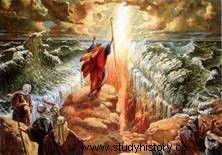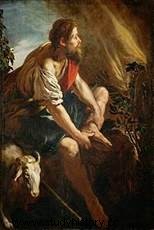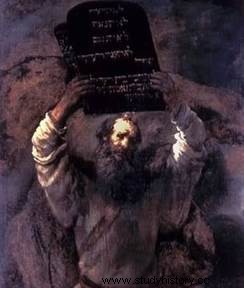 Moses is a character from the Bible, recognized by Jews, Christians and Muslims. Prophet of the Old Testament, he brought the Hebrews out of Egypt and took them to the Promised Land and received from Yavhé the Ten Commandments, the basis of the divine Law of the Hebrews. Apart from the biblical texts, there is little data on the actual life of Moses. So much so that the historian Édouard Meyer was able to declare, in 1906, that Moses is not a historical figure. Parting the waters of the Sea Red and brandishing the Tablets of the Law in a famous peplum film in the guise of Charlton Heston, Moses, who is mainly known to us from the Bible, and more precisely the Pentateuch, nevertheless had a decisive importance in the history of the Jewish people.
Moses is a character from the Bible, recognized by Jews, Christians and Muslims. Prophet of the Old Testament, he brought the Hebrews out of Egypt and took them to the Promised Land and received from Yavhé the Ten Commandments, the basis of the divine Law of the Hebrews. Apart from the biblical texts, there is little data on the actual life of Moses. So much so that the historian Édouard Meyer was able to declare, in 1906, that Moses is not a historical figure. Parting the waters of the Sea Red and brandishing the Tablets of the Law in a famous peplum film in the guise of Charlton Heston, Moses, who is mainly known to us from the Bible, and more precisely the Pentateuch, nevertheless had a decisive importance in the history of the Jewish people.
Who is Moses in the Bible?
Born in Goshen, Ancient Egypt (possibly 13th century BC), Moses belongs to the tribe of Levi, one of the twelve Hebrew tribes that migrated to Egypt in the 17th century BC. AD; son of Amran and Jochebed, his brother Aaron and sister Miriam.
Shortly before his birth, Moses escapes the repression of the pharaoh (perhaps Ramses II or his successor Merenptah) who strikes the Hebrew newborns to prevent any uprising. To save her son, the mother of Moses places the latter in a basket which she places in the reeds on a bank of the Nile. The child is taken in by the pharaoh's daughter, who takes pity, adopts him and raises him at the pharaoh's court as a prince. She gives him the name of Moses because, says the Bible, she “drew him out of the waters”. The origin of the name Moses most likely goes back to the Egyptian term mosu (“son” or “child”).
The "Burning Bush" episode
As an adult and aware of his origins, Moses discovers the misery of his people while visiting one of the construction sites where the Hebrews are working. His revolt drives him to kill an Egyptian who is persecuting one of his own. After his crime, Moses flees Egypt and reaches the country of Midian. There he finds protection with the priest Jethro, who gives him his daughter in marriage. During this exile, God would have appeared to him on Mount Horeb (in Sinai) in the form of a "burning bush", and would have assigned him a mission:to lead the Hebrews to bring them out of Egypt.
 Armed with divine revelation at the Burning Bush, Moses returns to Egypt to free the Hebrew people from slavery and guide him to the Promised Land, the land of Canaan. Helped by his brother Aaron, and endowed by Yahweh with the gift of performing miracles, Moses obtains an audience with the Egyptian sovereign, whom he asks to let the Jewish people celebrate Passover in the desert. The pharaoh refuses, despite the miracle of Aaron's staff transformed into a serpent, and intensifies the persecutions against the Hebrews. Moses is not discouraged, intercedes again but only gets refusal from the king.
Armed with divine revelation at the Burning Bush, Moses returns to Egypt to free the Hebrew people from slavery and guide him to the Promised Land, the land of Canaan. Helped by his brother Aaron, and endowed by Yahweh with the gift of performing miracles, Moses obtains an audience with the Egyptian sovereign, whom he asks to let the Jewish people celebrate Passover in the desert. The pharaoh refuses, despite the miracle of Aaron's staff transformed into a serpent, and intensifies the persecutions against the Hebrews. Moses is not discouraged, intercedes again but only gets refusal from the king.
In order to prove his omnipotence, Yahweh then intervened directly by bringing down a series of plagues on Egypt:the water of the Nile was turned into blood, the plague s fell on the Egyptian cattle, locusts cover the devastated land, darkness settles for three days…, finally, all the firstborn of the Egyptians die in one night. After the death of his son, whom Yahweh did not spare, the Pharaoh resolves to let the Hebrews go. Thus begins an exodus that will last forty years.
Exit from Egypt and crossing the Red Sea
The Hebrews think they have finally escaped the grip of the pharaoh, but the latter changes his mind and launches his chariots in pursuit. The Hebrews are facing the Red Sea (“the Sea of Reeds”) when they see the Egyptian troops. Moses stretches out his hand towards the sea whose waters split to leave a passage between the liquid walls; the people enter the corridor thus cleared. The Egyptians in turn enter the passage but Moses, at Yahweh's request, brings the sea back to its place and the Pharaoh's troops are swallowed up.
Guided by Moses, the people continue their journey. It is now the desert that the Hebrews must face in order to reach the country of their ancestors. Sensitive to the hunger and thirst of his people, Yahweh offers a flight of quails then a dew which, once evaporated, becomes hard as frost (the manna of the desert, prefiguration of the Eucharist), and finally water that Moses brings forth from a rock.
The Tables of the Law
 Three months after leaving Egypt, the Hebrews reached the Sinai Desert. Moses entrusts the people to his brother Aaron and goes to the foot of Mount Sinai. After forty days and forty nights of fasting, the prophet receives the Ten Commandments from God, the foundation of the Covenant between Yahweh and his people. When Moses joins the Hebrews, he sees that they have not had faith in God:with the help of Aaron, they have built a divinity in the image of a golden Calf that they idolize.
Three months after leaving Egypt, the Hebrews reached the Sinai Desert. Moses entrusts the people to his brother Aaron and goes to the foot of Mount Sinai. After forty days and forty nights of fasting, the prophet receives the Ten Commandments from God, the foundation of the Covenant between Yahweh and his people. When Moses joins the Hebrews, he sees that they have not had faith in God:with the help of Aaron, they have built a divinity in the image of a golden Calf that they idolize.
Moses' wrath is so great that he seizes the tablets of the Law that he received from God and breaks them, before burning the statue of the idol. However, the prophet begs Yahweh not to distance himself from his people and to forgive them; Yahweh hears his prayer and invites him to renew the Covenant on Mount Sinai. Moses comes down from the mountain forty days later, with two new tables of the Law.
The Hebrew people therefore undertake to follow the Law of Moses (or Mosaic law), which advocates a rigorous monotheism, as well as the fear and love of a Invisible, omniscient and almighty God. Moses then guides his people, Israel to Canaan. He dies on the threshold of the Promised Land, at the age of 120. His figure goes beyond the history of the Jewish people alone. It is of fundamental importance in the establishment and evolution of the primitive Judeo-Christian Church.
Bibliography
- Sigmund Freud, The Man Moses and the Monotheistic Religion, Gallimard, 1986.
- Charles Szlakmann, Moïse, Gallimard, coll. “Folio Biographies”, Paris, 2009
To go further
- The Ten Commandments, by Cecil B. De Mille. Fiction, on DVD.
